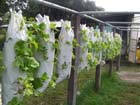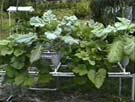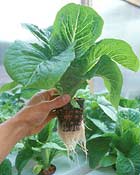Ebb & Flow - (Flood and Drain) System
Flood and Drain (Ebb and Flow) systems are very popular with home hydroponic growers for many reasons. Besides how easy they are for anyone to build, you can use almost any materials you have laying around to build them with, so you don't need to spend much money to grow plants hydroponically. Also they can be built to fit in any available space you might have (both indoors or outdoors), and there is no limit to the different and imaginative ways to design them for that space. Along with being inexpensive and easy to build, plants grow very well in flood and drain systems. The flood and drain system works basically like it sounds, by simply flooding the plants root system with nutrient solution. Only periodically rather than continuously.
How a hydroponic flood and drain system operates quite simple. The main part of the flood and drain system holds the containers the plants are growing in. It can be just one plant, or many plants/containers in series. A timer turns on the pump, and water (nutrient solution) is pumped through tubing from the reservoir up into the main part of the system using a submersible fountain/pond pump. The nutrient solution continues to fill (flood) the system until it reaches the height of the preset overflow tube so that it soaks the plants roots. The overflow tube should be set to about 2 inches below the top of the growing media.
When the water filling/flooding the system reaches the overflow tube height, it drains back down to the reservoir where it recirculates back through the system again. The overflow tube sets the water level height in the flood and drain system, as well as makes sure the water (nutrient solution) doesn't spill out the top of the system while the pump is on. When the pump shuts off, the water siphons back down into the reservoir through the pump (draining the system).
What you need to build a Flood and Drain (Ebb and Flow) system:
- A container for the plant's roots to grow in.
- A container (reservoir) to hold the nutrient solution.
- A submersible fountain/pond pump.
- A light timer to turn the pump on and off.
- Some tubing to run from the pump in the reservoir to the system to be flooded.
- An overflow tube set to the height you want the water level.
- Growing medium of some kind.
(Tip 1) Make sure there is a way air can get in the top of the overflow without spilling water out. A "T" connector with an extension that is a few inches above the water line will work nicely. This will keep air pockets from forming in the system and make sure it floods and drains properly.
(Tip 2) Make sure the overflow tube is bigger than the water inlet tube from the pump. Otherwise because the water is only going out through gravity, and water is coming in through pressure from the pump, you could wind up pumping in more water than what is going out the overflow. That would lead to water building up and spilling out the top of your system, unless you reduce the pressure (volume) from the pump.
There are basically three main types of flood and drain system setups
Plant containers in series design
This type of setup is most commonly used when many different containers with plants are being watered (flooded) at the same time. It's important to remember that the system with
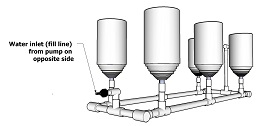 the plants (containers) to be flooded
(watered) needs to be above the reservoir, like on a table top or
bench. That way the water can flow back to the reservoir by simple
gravity, and thus drain the system correctly.
the plants (containers) to be flooded
(watered) needs to be above the reservoir, like on a table top or
bench. That way the water can flow back to the reservoir by simple
gravity, and thus drain the system correctly. First multiple containers are all connected
together through tubing so that when the system is flooded, they all flood evenly, and all at the same time. For simplicity, instead of having a separate overflow for each container being flooded, there's usually only one overflow tube. It connects to the system at the base where all the containers are connected to. And when the water height reaches the top of the overflow, it spills over
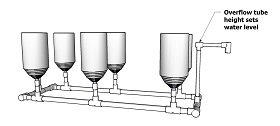 and goes back to the reservoir to be pumped
through the system again. The height of this one overflow tube will set
the height of the water level in all of the connected containers with
the plants in them (as long as it's level). You can change the water
height in all of the connected containers by simply adjusting the
height of the single overflow tube.
and goes back to the reservoir to be pumped
through the system again. The height of this one overflow tube will set
the height of the water level in all of the connected containers with
the plants in them (as long as it's level). You can change the water
height in all of the connected containers by simply adjusting the
height of the single overflow tube. Flooding tray design
The flooding table/tray flood and drain (ebb and flow) system type setup is useful when you want to place plants in the system temporarily, need to be moving them around a lot, or
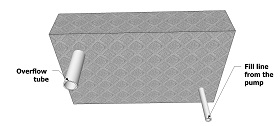 starting plants to be placed in another
larger system. Instead of flooding separate containers with plants in
it, this method only floods one container. Usually a shallow square or
rectangle container that sets on top of a table. The reservoir usually
sits directly underneath with easy access.
starting plants to be placed in another
larger system. Instead of flooding separate containers with plants in
it, this method only floods one container. Usually a shallow square or
rectangle container that sets on top of a table. The reservoir usually
sits directly underneath with easy access. 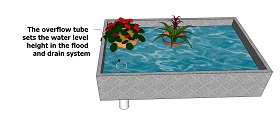 Water is
pumped up from the reservoir into the flooding tray on one side, and
the overflow is on the other side of the flooding tray. That makes sure
the water actually circulates from one side of the tray/table to the
other. Like any flood and drain (ebb and flow) system, the overflow
tube height sets the water height during the flooding cycle, and can be
adjusted as needed.
Water is
pumped up from the reservoir into the flooding tray on one side, and
the overflow is on the other side of the flooding tray. That makes sure
the water actually circulates from one side of the tray/table to the
other. Like any flood and drain (ebb and flow) system, the overflow
tube height sets the water height during the flooding cycle, and can be
adjusted as needed. 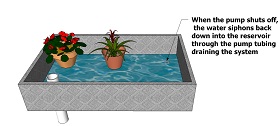 The plants are grown in regular plastic
pots or baskets, and placed in the flooding tray like regular potted
plants. However, unlike regular potted plants, hydroponic growing media
is used to pot the plants instead of using potting soil. Once the
plants get big enough, they can be transferred into a permanent
hydroponic system.
The plants are grown in regular plastic
pots or baskets, and placed in the flooding tray like regular potted
plants. However, unlike regular potted plants, hydroponic growing media
is used to pot the plants instead of using potting soil. Once the
plants get big enough, they can be transferred into a permanent
hydroponic system. One downside to using the flooding table is the algae growth, and should be cleaned out regularly. Because the top of the tray is usually left open, light is allowed to get in to the nutrient solution in the bottom of the tray, That allows algae to grow. The algae alone isn't really bad for the plants, but it does use up dissolved oxygen in the water.
Serge tank flood and drain (ebb and flow) system design
The
serge tank type of flood and drain setup is useful when more vertical
space is needed. Typically with flood and drain systems, the reservoir
is always lower than the hydropnic 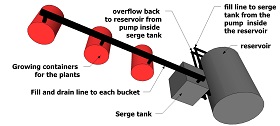 system. That's so the water
(nutrient solution) can drain out of the system through gravity back
into the reservoir through the overflow, and when the pump is off. But
you can still set up a flood and drain system even when the water level
in the reservoir is higher than the hydroponic system it's supposed to
flood and drain back from. That is with the use of a serge
tank.
system. That's so the water
(nutrient solution) can drain out of the system through gravity back
into the reservoir through the overflow, and when the pump is off. But
you can still set up a flood and drain system even when the water level
in the reservoir is higher than the hydroponic system it's supposed to
flood and drain back from. That is with the use of a serge
tank. The serge tank type of flood and drain system costs more to build because there are many more parts needed. It works on the principal
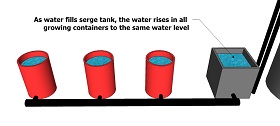 that water seeks it's own level. In
other words, the water height in one container will be the same in
another container when they are connected below the water line. The
serge tank serves as a temporary reservoir that controls the water
height in all the containers with the plants in them, and is only full
during the flooding cycle.
that water seeks it's own level. In
other words, the water height in one container will be the same in
another container when they are connected below the water line. The
serge tank serves as a temporary reservoir that controls the water
height in all the containers with the plants in them, and is only full
during the flooding cycle. 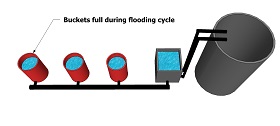 The serge tank flood and
drain (ebb and flow) system operates by pumping water (nutrient
solution) from the much larger main reservoir into the serge tank when
the pump timer goes on. As the water level rises in the serge tank, the
water level rises evenly in all the connected plant containers at the
same time. When the water level gets high enough, a float valve in the
The serge tank flood and
drain (ebb and flow) system operates by pumping water (nutrient
solution) from the much larger main reservoir into the serge tank when
the pump timer goes on. As the water level rises in the serge tank, the
water level rises evenly in all the connected plant containers at the
same time. When the water level gets high enough, a float valve in the
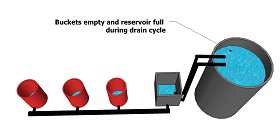 serge tank turns on a pump in the serge tank. The pump in the serge
tank then pumps water back into the main reservoir. At this time both
the pumps are on (pump in main reservoir, and serge tank).
serge tank turns on a pump in the serge tank. The pump in the serge
tank then pumps water back into the main reservoir. At this time both
the pumps are on (pump in main reservoir, and serge tank). After the timer for the pump in the main reservoir shuts off, the pump in the serge tank is still on. The pump in the serge tank continues pumping all the water back into the main reservoir (draining the system) until the water level gets low enough. At that point a second float valve shuts off the pump in the serge tank.


